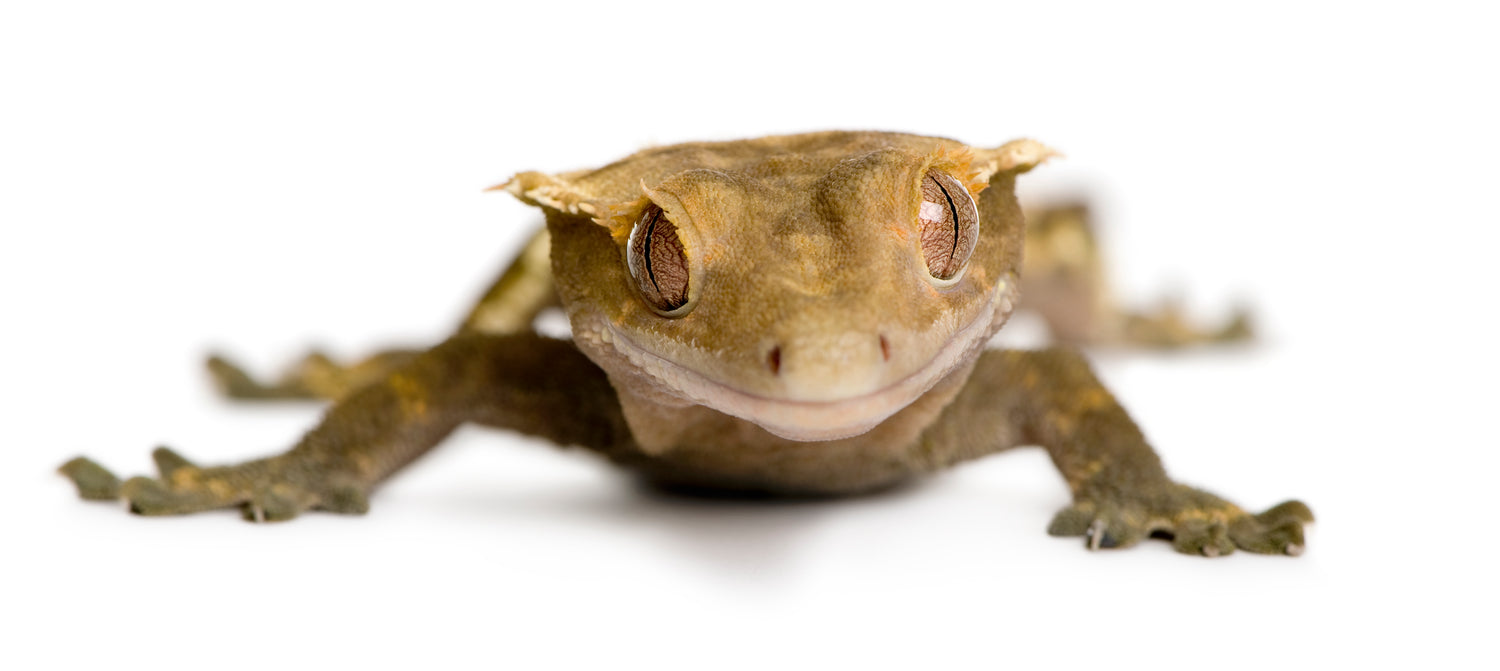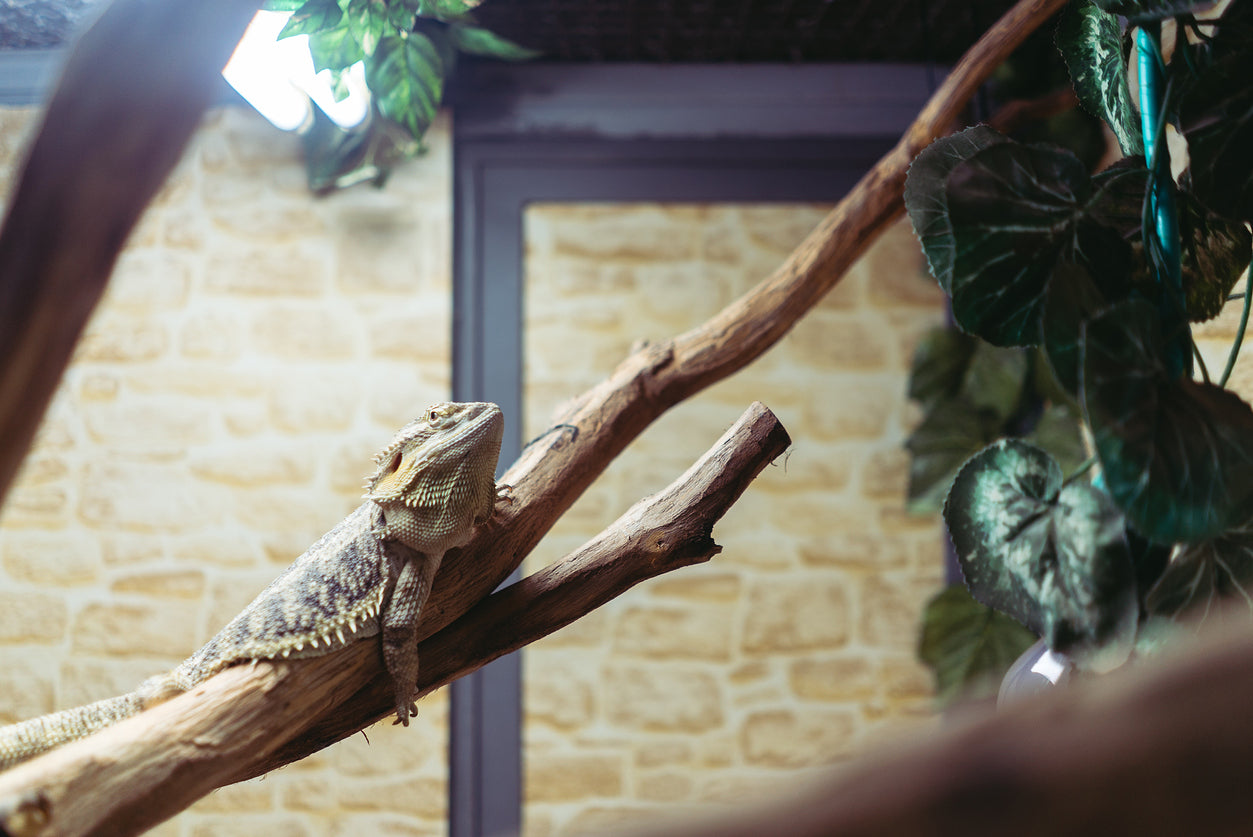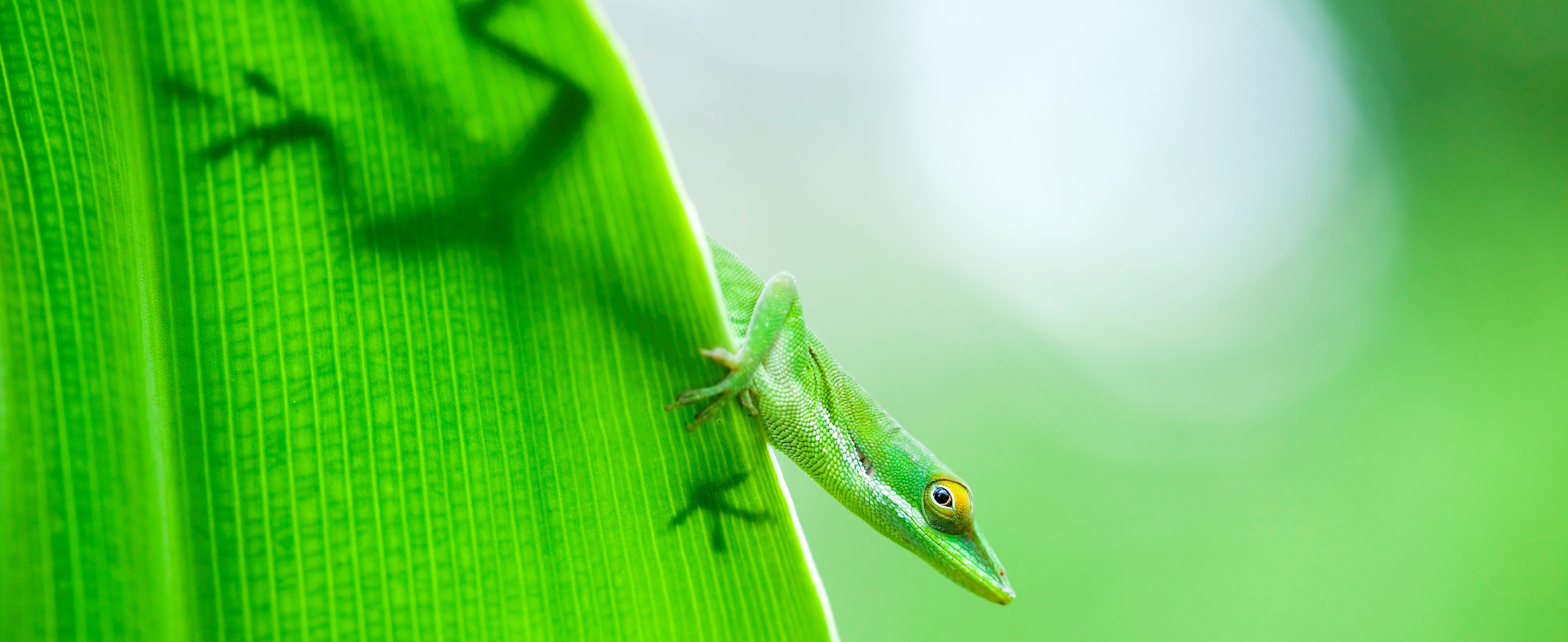Table of Contents
Introduction
Crested geckos (Correlophus ciliatus) are small, 6-8” long arboreal lizards native to the tropical forests of New Caledonia, particularly the islands of Grande Terre and the Isle of Pines.
In the wild they are generally tan to light brown in color, with a large triangular head, large feet, sticky toe pads, a prehensile tail, and a fringe that runs from their eyes down their back, giving them the appearance of having eyelashes. They do not have eyelids. In captivity, crested geckos have been bred to be available in a wide variety of patterns and more color variation.
Crested geckos are one of the most popular pet lizards in the US, due to their small size, hardiness, ease of breeding, ease of care, and tolerance for human interaction. This also makes them good pet reptiles for first-timers. With good care, they can live 15-20 years.
Enclosure
How much space do crested geckos need?
Crested geckos are not very active compared to other arboreal lizards, but they still need an enclosure that is large enough to allow them to thermoregulate and exercise other natural behaviors. A single crested gecko should be housed in absolutely no smaller than an 18” x 18” x 24” terrarium, although larger is always better, and will be happily used!
Is it safe to house multiple crested geckos together?
Cohabitation (keeping multiple crested geckos in one enclosure) is not recommended, and may result in fighting if attempted. This is especially the case for males that are housed together, but can also happen with females.
Crested gecko quarantine procedure
It’s best practice to quarantine your crested gecko first. Quarantine is the practice of keeping an animal isolated and under sterile conditions in order to reduce the potential spread of disease.
Even if you don’t have other reptiles that could potentially get infected by anything the gecko might be carrying, maintaining quarantine conditions for the first 3 months will enable you to more easily monitor for concerning symptoms and more easily treat them as well. You can do this with the enclosure that you plan to keep the gecko in long-term, or you can do this with a tall plastic tub. As long as it is set up appropriately, a tub can make appropriate short-term quarantine housing.
Some rules for successful crested gecko quarantine:
- Keep the gecko in a separate room from other reptiles.
- Do not use the same equipment for the new gecko as for your other reptiles.
- Fully disinfect the enclosure weekly.
- Get the gecko checked by an experienced reptile veterinarian and treated for parasites if needed.
- Observe for symptoms of disease or illness.
A crested gecko should be completely healthy before being transferred out of quarantine to its long-term setup.
Lighting
Do crested geckos need UVB?
They can survive without it, but it’s still recommended. UVB gives them all of the vitamin D that their bodies need, stimulates better appetite and activity, and generally allows them to be healthier than they would be without.
Crested geckos do best with low-strength UVB as part of their enclosure. The best UVB bulbs for crested geckos housed in an 18” x 18” x 24” terrarium are:
- Zoo Med T8 ReptiSun 5.0, 18”
- Zoo Med ReptiSun 5.0 Compact Fluorescent, 26w
- Arcadia ShadeDweller Kit, 12”
The UVB bulb should be housed in a reflective fixture and placed close to the heat lamp, about 6” above the basking branch. UVB is blocked by glass and plastic, so you can’t give your gecko UVB by placing its terrarium in front of an open window. Also make sure that the fixture your UVB bulb is in does not have a clear plastic bulb cover.
Crested geckos should receive 11 hours of light during winter and 13.5 hours of light during summer. This simulates natural seasonal changes in day length and encourages healthier hormonal rhythms.
How to measure UVB for a crested gecko
UVB strength is measured by UV Index, or UVI. This is most accurately done with a device called a Solarmeter 6.5. When you hold the Solarmeter vertically near the basking surface at the height of the gecko’s back, the device should read between 1.0-2.0.
Factors such as the density of the mesh over your enclosure and the exact fixture you’re using can affect exactly what basking distance is needed to achieve the right UVI.
Heating
What basking temperatures do crested geckos need?
Despite popular myth, crested geckos do benefit from having a basking area. After all, they’re still ectotherms, which means that they need a temperature gradient in their enclosure to help them regulate their metabolism and stay healthy.
Crested geckos should have a low basking temperature between 82-85°F. The cool zone in the lower regions of the enclosure should stay between 70-75°F. Heat lamps should be turned off at night. Nighttime temperatures can drop as low as 65°F.
How to heat your crested gecko
Provide heat for your gecko by imitating the sun with a low-wattage heat lamp placed on one side of the enclosure, with a branch or vine directly underneath for the gecko to perch on. Ideally, there should be foliage or some other type of cover close nearby to help the gecko feel more secure about basking.
Do not use ceramic heat emitters (CHEs), red bulbs, or blue bulbs, as these are not as effective.
How to measure temperature
To measure your basking temperature, use a digital probe thermometer with the probe placed on the basking surface. To measure cool side temperature, use another thermometer with the probe placed lower in the enclosure, in the shade. This will allow you to monitor the temperature gradient.
Do not use analog or stick-on thermometers, as you will not be able to get accurate readings, which can be potentially harmful to your pet.
Humidity
What humidity levels do crested geckos need?
Crested geckos are a tropical species and need a high humidity environment with an average humidity of 60-80%, as measured by a digital probe hygrometer with the probe in the middle of the terrarium.
How to increase and maintain humidity
Misting your gecko’s enclosure with a sprayer first thing in the morning and again at night (if needed) will help create the right humidity levels. Moisten the substrate by mixing water into it as needed can also help stabilize humidity levels.
It’s also a good idea to run a cool mist fogger/humidifier at night, because humidity levels are naturally higher at night in the wild. Connect the fogger to a humidistat to maintain nighttime humidity levels no lower than 80%.
Although crested geckos need plenty of humidity, keep in mind that the enclosure needs a humidity cycle, not stagnation. If there isn’t enough ventilation to allow the enclosure to dry out at least a bit during the day, then your gecko is more likely to get sick due to increased pathogen growth. Installing a small computer fan on top of the enclosure to help keep things moving may be necessary.
Substrate
What substrate is good for crested geckos?
Although crested geckos are an arboreal species and don’t spend much time on the ground, placing a layer of substrate on the floor of the enclosure helps maintain humidity. As an added perk, it also tends to make the enclosure more attractive.
Ideally, this substrate should resemble what crested geckos naturally live on in the wild — in this case, tropical soil. It should have small particles and hold moisture well. We recommend the following substrates for crested geckos:
Layering clean, chemical-free leaf litter on top of the substrate can also help with humidity.
Substrate should be at least 2” deep and completely replaced every 3-4 months. Remove poop and urates daily, along with contaminated substrate.
How to clean a crested gecko enclosure
When you replace your crested gecko’s substrate, this is also a good opportunity to completely clean out the entire enclosure:
- Remove your gecko from the enclosure and place inside a temporary, escape-proof holding container.
- Remove all substrate and décor.
- Vacuum and wipe down the enclosure to remove leftover particles.
- Apply a reptile-safe disinfectant to the floor and walls of the enclosure and let sit for the disinfectant’s recommended contact time.
- Meanwhile, soak branches, rocks, hides, and other décor in a disinfectant rated for porous materials for the recommended contact time.
- If required, rinse the enclosure and the accessories with clean water to remove disinfectant residue. Allow everything to dry.
- Pour new substrate into the enclosure. Mix in water until uniformly moistened but not wet.
- Arrange décor.
- Reintroduce your pet to the clean setup.
F10SC, CleanBreak, and bleach solution (1:10 dilution) can be used for disinfecting porous materials. The same can be used for nonporous materials, although the concentration of bleach solution should be changed to 1:50.
Can crested geckos have a bioactive setup?
Yes!
Crested geckos are definitely compatible with bioactive when it’s done properly. Bioactive setups can work great with crested geckos because it helps stabilize humidity levels. Plus, bioactive eliminates the need for routine total cleanouts, tends to have a fresh, earthy smell; and is generally very attractive to look at.
On the other hand, bioactive setups can be inconvenient because the vivarium needs at least one month to get established before adding the gecko, you need plants that can withstand gecko traffic, and larger CUC critters are likely to get routinely eaten. Setting up a bioactive enclosure is also usually more expensive than other options, and it’s best practice to partially replace the substrate on a regular basis to help reduce pathogen concentration and keep the soil healthy.
To create a bioactive setup for your crested gecko, you will need all of the usual supplies mentioned in this article, as well as:
- bioactive-ready tropical substrate mix
- clean leaf litter
- sphagnum moss
- live, nontoxic plants
- tropical CUC (Clean Up Crew) organisms to maintain the soil
If it’s your first time setting up a bioactive vivarium, it’s best to use a commercial bioactive substrate mix, such as Bio Dude or Josh’s Frogs, rather than mixing your own, as this reduces your likelihood of error. Appropriate CUC for a crested gecko vivarium include dwarf white isopods, powder orange/blue isopods, springtails, mealworms, and superworms.
Décor
What décor can you use in a crested gecko terrarium?
It’s terribly boring for a gecko to be stuck in an enclosure with nothing in it except substrate and food/water bowls. It doesn’t matter how big the enclosure is if you don’t put things in it for your pet to use and interact with. Crested geckos appreciate a fairly densely planted enclosure with either live or artificial plants, which can make their terrarium a great piece of home décor!
At bare minimum, you will need a branch for your gecko to climb on and some live or artificial foliage for it to hide in. However, it’s best to include other items, such as:
- branches and vines
- cork tubes
- ledges
- live or artificial plants
What live plants can be used with crested geckos?
Since crested geckos are climbers, any live plants you decide to use in the enclosure must be sturdy enough to support the weight of the gecko without getting crushed, so sensitive varieties are not a good idea. Here are a few options that work well in a humid, moderately-lit environment:
- Dracaena
- Ficus
- Peperomia
- Philodendron
- Pothos
- Schefflera
- Spider plant
Note that larger plants are usually sturdier, which is one argument for using a taller enclosure such as a 2x2x4.
Are crested geckos good climbers?
Crested geckos may live in trees, but they also have something of a reputation among pet owners as being a bit clumsy, which can come across as saying that crested geckos are poor climbers/too clumsy to do so safely. And that is not the case!
Crested geckos may not be the stickiest geckos, but they are still capable climbers. The only reason why a pet crested gecko might seem bad at climbing is because it hasn’t had enough opportunity to practice. If you start your gecko with climbing opportunities from a young age, it will learn to climb quite skillfully!
If you have an older gecko that doesn’t have a lot of experience with climbing (ex: it was housed in a small enclosure or with limited climbing opportunities), start with wide climbing objects and grippy surfaces that will help increase your pet’s muscle tone while decreasing the risk of falls.
Food
What do crested geckos eat?
Crested geckos are omnivorous, which means that they need to eat a balanced diet of plant and animal matter in order to get the nutrition that their bodies need. In the wild, they primarily eat insects and fruit. In captivity, it’s best to feed them high-quality, specially-formulated crested gecko diet (CGD) supplemented by live insect feeders.
How often crested geckos need to eat depends on age:
- Hatchlings and Juveniles (0-12 months) — CGD daily, insects 1-2x/week
- Adults (>12 months) — CGD every 2-3 days, insects 1x/week
Prepared diets for crested geckos
There are many high-quality and trustworthy crested gecko diets (CGD) that can be used as the primary source of nutrition for your pet. Here are some with the best reputations:
A varied diet is important to complete nutrition and providing a source of sensory enrichment. Strive to use a rotation of at least 3 different flavors of CGD with your gecko.
Feeder insects for crested geckos
Although technically crested geckos can survive on just high-quality CGD, it’s best practice to offer feeder insects as well — especially when the gecko is young and growing. Here are some suitable options:
For best nutrition, feeder insects should be gutloaded and hydrated with a high-quality insect diet such as Arcadia Insect Fuel for at least 24-48 hours prior to feeding.
Do crested geckos need dietary supplements?
Although crested gecko diet doubles as a vitamin supplement, you will need calcium powder to dust on feeder insects. We recommend Repashy Supercal NoD or Arcadia EarthPro CalciumPro Mg.
How to provide drinking water for your crested gecko
Although your gecko will get most of its drinking water from daily mistings, it’s a good idea to also provide a wall-mounted water dish. Change the water daily and scrub the bowl with a reptile-safe disinfectant weekly, or whenever it becomes soiled.
Handling
Do crested geckos like to be handled?
Few reptiles actually “like” to be held, but crested geckos generally tolerate handling well. Be gentle, and whenever possible, pick up the gecko from below instead of grabbing it from above — this approach is less scary and stressful for them. They may be a bit jumpy at first, so let them hop from one hand to the other until they have calmed down.
How to tame your crested gecko
Taming a crested gecko means teaching it to trust and feel comfortable around you. This requires consistent positive interactions to build the trust relationship. While a negative experience or two won’t ruin your taming efforts, it can slow them down, so it’s best to be consistent. It’s best to encourage the gecko to come out of the enclosure and climb onto you on its own, rather than forcibly grabbing it. Avoid removing it from its hiding places, as hides are supposed to be safe, private places.
Using treats, or tong-feeding, is a great way to bribe your pet into interacting with you and learning to trust you!
Enrichment ideas for crested geckos
Enrichment is what good zoos use to keep their animals happy, active, and engaged. Some say that reptiles are too stupid to benefit from enrichment, but this is false. Reptiles, including crested geckos, can absolutely benefit from enrichment when it is provided in appropriate ways for a small nocturnal lizard.
Here are some ideas for enrichment activities that your gecko is likely to enjoy:
- Rearrange the enclosure. If total overhauls are too stressful, move one thing every so often at your pet’s pace. For some individuals, that may be once a month, for others they might like once a week.
- Organize a treasure hunt. Every once in a while, move the feeding platform to a new spot to stimulate your gecko’s foraging instincts!
- Offer supervised explore time outside of the enclosure. Make sure to keep them away from situations that you can’t get them out of.
Health
Signs you need to take your crested gecko to the vet
Veterinary care is an important part of having any pet, including crested geckos. If you notice any of these signs or symptoms, make an appointment with an experienced reptile vet to get them checked out immediately.
- Mucus discharge from the mouth/nose/eyes
- Persistent lethargy
- Unexplained weight loss
- Persistent lack of appetite
- Straining/inability to defecate
- Large patches of missing scales
- Open wounds
- Swelling or bumps anywhere on the body
- Sudden, unusually aggressive behavior
Crested geckos should be taken to the vet shortly after you bring them home, and then at least 1x/year for a general checkup and parasite check.
Outside of that, if you are concerned about your pet’s health due to a change in their appearance or behavior, don’t go to the internet for medical advice — book an appointment with a professional! You can find an experienced reptile veterinarian near you at ARAV.org.
Resources
This care sheet contains only very basic information. Although it’s a good introduction, please do further research with high-quality sources to obtain additional information on caring for this species. Here are some other great sources to read:
- The ReptiFiles Crested Gecko Care Guide
- Moon Valley Reptiles
- Crested Geckos in Captivity by Robbie Hamper
- Crested Geckos by Philippe de Vosjoli




2 comments
Leave a comment
This site is protected by hCaptcha and the hCaptcha Privacy Policy and Terms of Service apply.